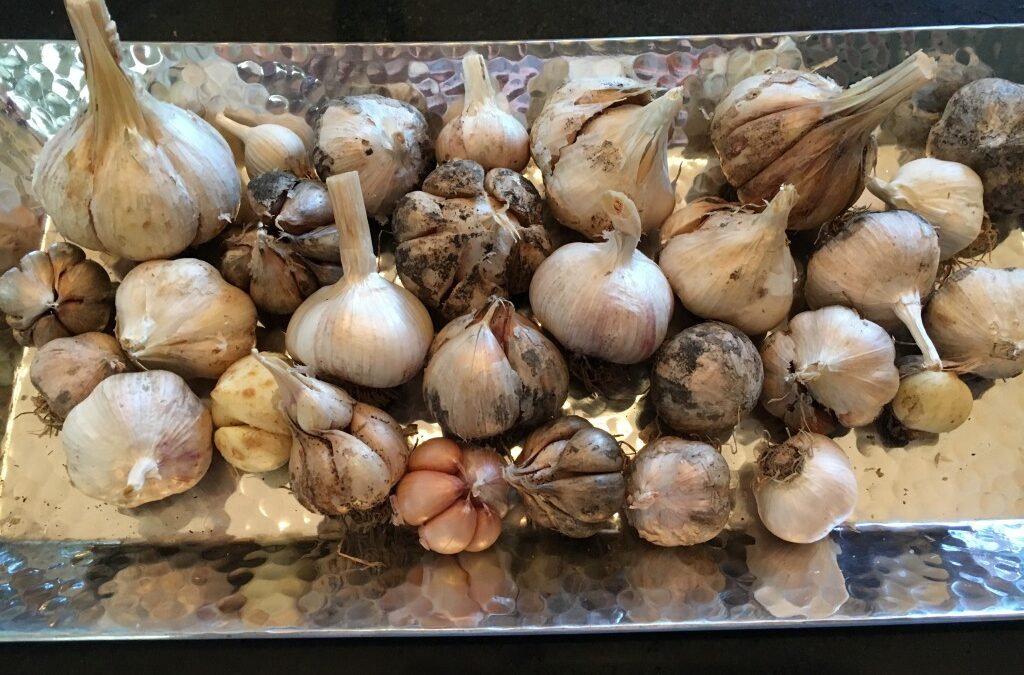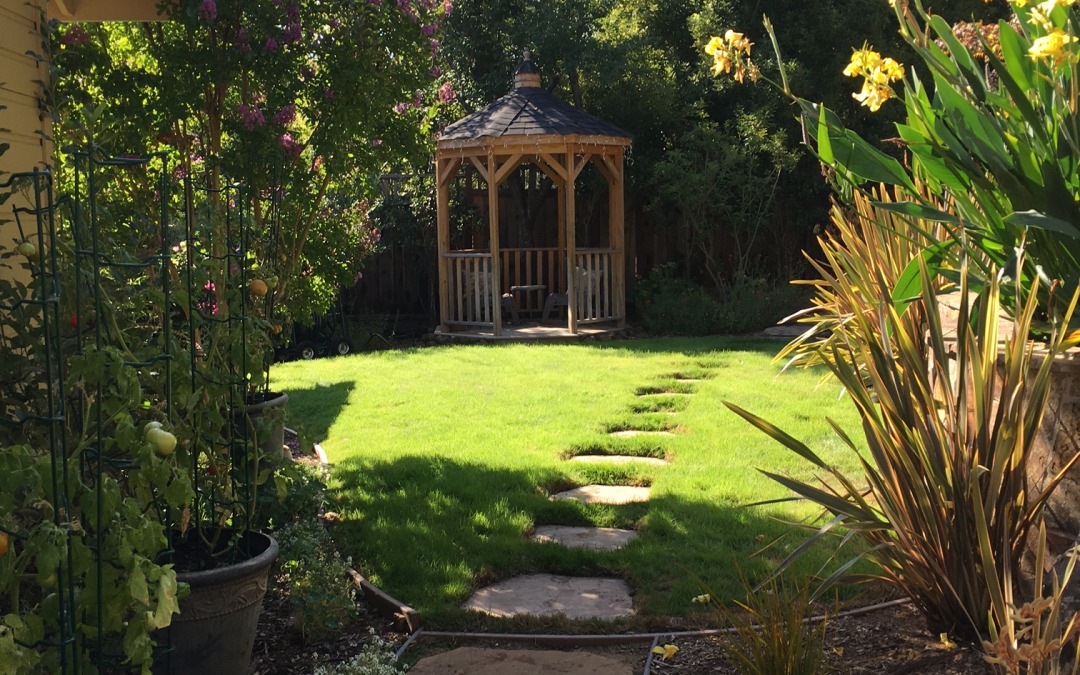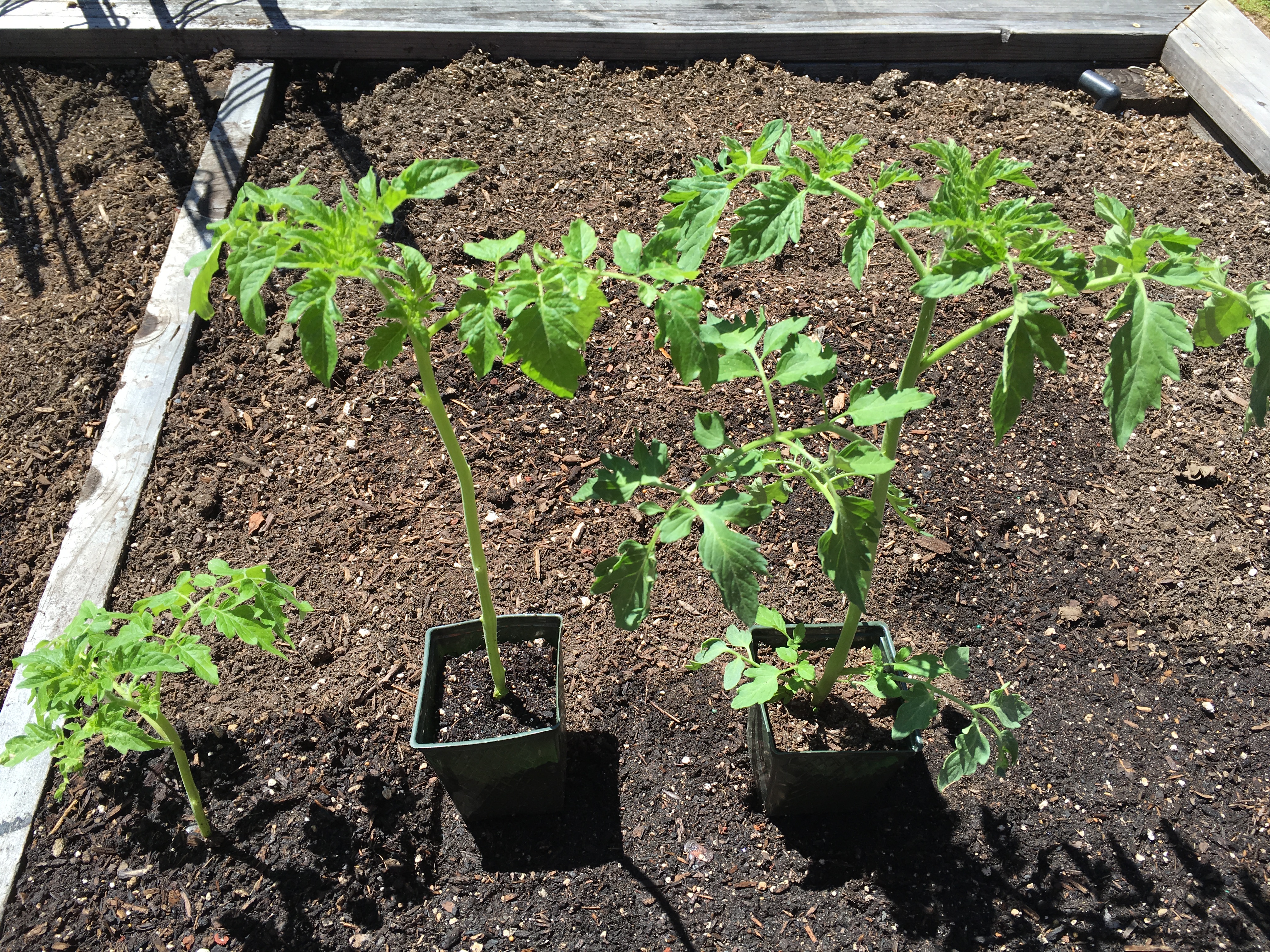Chef Rebecca Tip!! - January
January 12th, 2021

Other than with pies, cakes and pancakes, I use garlic in almost all of my meals. I love it in a breakfast frittata, as an aioli on my lunchtime sandwich and I can’t image cooking sautéed veggies, stirfrys or pastas for dinner without it.
Garlic, a member of the Allium — onion — family, is easy to grow and takes up very little space in the garden.
There are more than 600 varieties of garlic grown, and although China produces most of the world’s garlic, California produces more than any state in the nation.
Garlic is believed to prevent cardiovascular problems, reduce cholesterol and lower blood pressure, and has been used to treat asthma, diabetes, atherosclerosis and a host of other ailments.
Santa Clara Master Gardener Sue Zaslaw, an expert on the stinking rose, says homegrown garlic is more nutritious and much more flavorful than supermarket garlic. By growing your own, you can choose the varieties based on size, shape and, of course, taste.
Sue inspired me so much that I planted seven varieties last fall. I was completely surprised by how different each tasted and the assortment of cloves sizes.
Most garlic is either hardneck, with a hard, woody center stalk, or softneck, which lacks a central stalk. Hardnecks tend to have fewer cloves — 4 to 12 — and have more flavor. They grow well in cooler climates, but don’t store as long as softnecks. They also produce flowering tops, called scapes, that are delicious when cooked.
Softnecks can produce up to 30 cloves and have a milder taste. The stalks can be braided for hanging storage. If you have both, use your hardnecks first as they will not last as long as the softnecks.
The best time for planting garlic is now through the end of November. Break the bulbs into individual cloves just before planting. Remove the outer papery wrapping, but be sure to leave the covering on the individual cloves.

Although we did have a few wonderfully wet weeks last winter, El Niño didn’t really deliver the deluge we were hoping for. So, when it comes to water, how are we really doing?
The answer is mixed. Although, we made great inroads into saving water, we need to continue conserving.
Our rain-year runs from July 1 to June 30, and fortunately, we got 96 percent of the annual average. The numbers were so good that this spring the State Water Resources Control Board updated its emergency regulations, allowing water retailers throughout the state to set their own restrictions based on local conditions and requirements beginning in June.
Many water districts in the Bay Area chose to ease restrictions or drop them altogether. Santa Clara Valley Water District, for example, reduced its restrictions to 20 percent from 30 percent, while Fremont, Newark and Union City dropped their reductions all together.
Some worried that the savings we saw under the mandatory restrictions would evaporate when residents began relying on their best judgment on how much and how often they water their landscapes; however, recent numbers show that we are continuing to conserve.
In June, compared to the same month last year, San Jose Water Company cut water use by 27.8 percent, East Bay Municipal Utility District by 18.1 percent, Santa Cruz by 20.9 percent, Alameda County Water District by 28.7 percent and Palo Alto by 17.9 percent.
“Our main message to the public right now is ‘Thank you’ for the tremendous response to the drought and the savings that have been achieved over the last year,” says Jerry De La Piedra, unit manager for the Santa Clara Valley Water District. “However, one average year doesn’t erase four years of historic drought. We don’t know what next year will bring, so we’re asking everyone to continue to use water as efficiently as possible.”
Fall is a great time to rethink and replant your lawn, renew your garden, or make major water-saving changes to your landscape. By planting new eco-friendly sod or native and Mediterranean plants, you will not only significantly cut back on your water use, you will be providing necessary food and shelter to help save our endangered birds, bugs and bees.
Try replacing your lawn with a gorgeous array of plants and shrubs that produce flowers and create interest all year long.
If you just can’t bear to completely lose the lawn, try planting a smaller section of one of the many varieties of Delta Blue Grass California native sods. They roll out just like regular sod but require 50 percent less water. They also need to be mowed way less often, resulting in environmental savings well beyond water.
Look for city and county rebate programs that actually pay you to replace your water-guzzling lawns and replace older, inefficient irrigation controllers and sprinkler equipment.
You truly can go greener without the expansive, traditional lawn.
Although we did have a few wonderfully wet weeks last winter, El Niño didn’t really deliver the deluge we were hoping for. So, when it comes to water, how are we really doing?
The answer is mixed. Although we made great inroads into saving water we need to continue conserving.
Many water districts in the Bay Area chose to ease restrictions or drop them altogether. Santa Clara Valley Water District, for example, reduced its restrictions to 20 percent from 30 percent, while Fremont, Newark and Union City dropped their reductions all together.
Some worried that the savings we saw under the mandatory restrictions would evaporate when residents began relying on their best judgment on how much and how often they water their landscapes; however, recent numbers show that we are continuing to conserve.
In June, compared to the same month last year, San Jose Water Company cut water use by 27.8 percent, East Bay Municipal Utility District by 18.1 percent, Santa Cruz by 20.9 percent, Alameda County Water District by 28.7 percent and Palo Alto by 17.9 percent.
Try replacing your lawn with a gorgeous array of plants and shrubs that produce flowers and create interest all year long.
If you just can’t bear to completely lose the lawn, try planting a smaller section of one of the many varieties of Delta Blue Grass California native sods. They roll out just like regular sod but require 50 percent less water. They also need to be mowed way less often, resulting in environmental savings well beyond water.
Look for city and county rebate programs that actually pay you to replace your water-guzzling lawns and replace older, inefficient irrigation controllers and sprinkler equipment.
You truly can go greener without the expansive, traditional lawn.
Rebecca Jepsen is a Santa Clara County Master Gardener.

Jul 20, 2016 | Rebecca in the Mercury News
If you see holes like this in the ground, with debris around the entrance and little piles of castings nearby, there is a good chance they were created by earthworms, which help aerate and feed the soil. (Courtesy of Jack Kelly Clark/UC Statewide IPM Program)
Do you have an area in your yard where you just can’t get anything to grow? Have you struggled repeatedly with a prized plant or tree that just won’t thrive? If you know what type of soil you have and are watering properly, it may be time to dig a little deeper to find out what’s going on.
Check your soil texture. It dictates the way your soil drains and the amount of nutrients available to your plants. Providing the appropriate amount of water across the entire bed and at the right time also is of utmost importance.
Soil compaction is the next thing to look for. When soil is compacted, the air pockets are compressed, making it harder for roots to expand and grow and therefore harder for the plant to take up water and nutrients. Soil becomes compacted by foot traffic, use of heavy machinery, working the soil in overly wet conditions or when proper amendments — organic matter — haven’t been added.
To improve your soil, apply a 2- to 4-inch layer of compost once or twice a year.
Aerating, especially in lawn areas, also can be helpful.
Soil pH is another important factor; it determines how acidic or alkaline the soil is, which affects plant growth, soil bacteria, availability of essential nutrients and soil structure as well.
Acidic soil has a low pH, and extremely low levels can cause a plant to become stunted or die. Plants that thrive in acidic soil include blueberries, azaleas, rhododendrons, hydrangeas, gardenias, camellias, crepe myrtles and pine trees. Adding soil sulfur, peat moss or iron sulfate will decrease the pH level.
Alkaline soil is high in pH and is generally deficient in nitrogen and other important minerals. A high-alkaline soil has higher levels of sodium that may be toxic to plants. Plants that grow in alkaline soil include clematis, heuchera, delphinium and dianthus.
If your plants have pale green or yellowing leaves, that may be a sign of nitrogen deficiency. Plants may be stunted or have much smaller leaves than normal. To increase nitrogen, add good-quality compost; grow cover crops, such as fava beans, borage and vetch, in the offseason; or add coffee grounds to the soil.
The amount of soil organic matter — decomposed plant and animal residues — really does matter. It has been called the most complex and least understood component of soils. High levels of soil organic matter improve water and nutrient retention; help fend off compaction and erosion; balance pH levels; and even bind harmful pesticides and trace elements, keeping them from polluting our watersheds.
To increase soil organic matter, apply compost and mulch, reduce tillage, leave grass clippings on the lawn and rotate crops in your garden.
Earthworms are an excellent and essential indicator of healthy soil. They create burrows in the soil, allowing water to move through the soil and roots to more easily expand and grow. Dig out about 6 inches of soil and count the number of worms you find. Three to five is a good indication of a healthy soil. If you don’t see any, your soil is lacking in organic matter.
Jun 22, 2016 | Rebecca in the Mercury News
Knowing soil types and water requirements may help us grow healthy vegetable gardens and flowers, but it is also vital when it comes to trees.
Igor Lacan, environmental horticulture adviser for UC Cooperative Extension, says as we move toward warmer temperatures with less predictable annual rainfall, we will need to make smart choices about our landscapes.
“Even in a drought, it is essential to prioritize your trees,” Lacan says. “Trees not only support our native birds, bees and wildlife, they provide major ecosystem services to us as well. Urban trees lower the ambient temperature, thereby reducing the need for air conditioning, sequester carbon from the atmosphere, provide stormwater capture, decrease pollution and enhance the property value and aesthetics of your home.”
START WITH SOIL
In order to practice responsible irrigation — using enough water to keep a plant alive and no more — knowing your soil type really does matter.
Soil type, or texture, refers to the proportions of sand, silt and clay particles in its makeup. Sandy soils are coarse and drain quickly. Plants in sandy soil need frequent watering and may need fertilizer.
Clay particles are very fine and become glued together when wet, and although clay soil can be slow to drain, it retains moisture and minerals, requiring little to no fertilizers.
The roots of newly planted plants may have a harder time getting started if the soil is hard and dense, but once established, plants tend to thrive in clay soils.
Silty soil is found along our riverbeds, lakes and other riparian areas. Particles are smaller than sand but not as fine as clay. It drains well and has good nutrient retention.
Loam represents a combination of sand, silt and clay and most of the Bay Area has clay or loam soil.
To tell what kind of soil you have, moisten a handful of it and give it a firm squeeze. If it holds its shape but crumbles when you give it a poke, you have loam. If it holds its shape without crumbling, you have clay. If it falls apart as soon as you open your hand, you have sandy soil.
Knowing your soil type will guide you in how much water to apply and how often.
To gauge soil moisture levels, you will need to dig down to the root level. For trees, use a shovel or an auger to get 12-18 inches below the surface. After watering to this depth, soil should be moist but not drenched.
For mature trees, deep water infrequently, about once a month. Imagine refilling a 12- to 18-inch deep water reservoir around the tree’s roots.
It’s important to water beneath the entire canopy. Installing a Tree Ring Irrigation Contraption (TRIC) is a great way to accomplish this.
Newly planted trees may need only 10-15 gallons per week, but they may need additional water in extremely hot weather.
In all cases, a good rule of thumb is to water deeply and observe your tree. If the tips of the leaves and branches start to droop, it’s time to water again.
You will then be able to properly set up your automated irrigations systems. But remember, they need to be changed seasonally as the weather and temperature fluctuate. Online watering calculators can also be helpful.

Apr 27, 2016 | Rebecca in the Mercury News
To ensure that your prized tomatoes are able to put their “best roots” forward, pinch before you plant. Seasoned gardeners know that pinching off all the lower leaves and leaving just the top 2 to 3 sets will make for a much better plant. Allow the “wounds” to heal for a few days; then plant in a deep hole or sideways in a trench so that only the reaming leaves are above the soil. This allows roots to form where the leaf nodes were, resulting in a much stronger, more stable plants as it grows.
Prepare your soil by mixing in 2-3 inches of compost. Add in some organic fertilizer if your soil is lacking in nutrients, or not that healthy. For raised beds or containers, add in some fresh potting soil and slow-release organic fertilizer to ensure plants have the nutrition they need to grow and produce. Choose area that gets at least 6-8 of sunlight per day. To avoid problems with fungus and disease, don’t plant in an area where you have grown nightshades (tomatoes, eggplants or peppers) in the last 3 years. This will help to avoid pesky problems with Fusarium wilt and Verticillium wilt – two common fungal diseases that affect tomatoes.
Fusarium wilt invades the plant through its roots. It is a serious problem that causes branches and leaves to become yellow and wilt; infected plants usually die. Use plants (labeled F) to avoid this problem.
Verticillium wilt causes leaves to turn from yellow to brown and fall off. The infection usually appears in a V-shaped pattern. Although it seldom fatal, it reduces vigor and yield. Due to significant leaf drop, sun damage to the fruit can occur. Buy plants labeled V or VF to avoid this issue.
Blossom end rot is caused by a calcium deficiency in the fruit. Symptoms first appear as a water-soaked spot near the blossom end of the fruit. The spot will become brown, leathery and sunken and may cover half of the fruit’s surface. There is no cure for an affected plant, but the fruit is still edible; just cut off the damage and enjoy the rest. Regular and deep irrigation will help avoid this problem.
One of the most common tomato ailments is tobacco mosaic virus. It causes light green, yellow or white mottling on leaves; leaves may become stringy or distorted. It is usually caused from contact by those who use tobacco products. Don’t smoke or allow tobacco in or near your garden. Look for disease resistant plants (labeled T).
Tomato and/or tobacco hornworms cause extensive damage to both the plant and fruit. Look for visible black droppings and/or eggs on the leaves. The worms can grow up to 4 inches in length. It is best to hand pick and discard them. If necessary, spray with Bacillus thuringiensis (BT).
Russet mites are minute pests that can’t be seen by the naked eye. Use a hand lens to identify their yellowish, conical-shaped bodies. They feed on leaves, stems and fruit; if not controlled they will usually kill the plant. Apply sulfur (dust or spray) to young plants and avoid planting near petunias, potatoes, or other solanaceous plants that are often a host for the pest.
Blossom drop is caused by environmental issues: insufficient pollination, lack of water, extremely high or low temperatures, even smog – conditions we really can’t control.